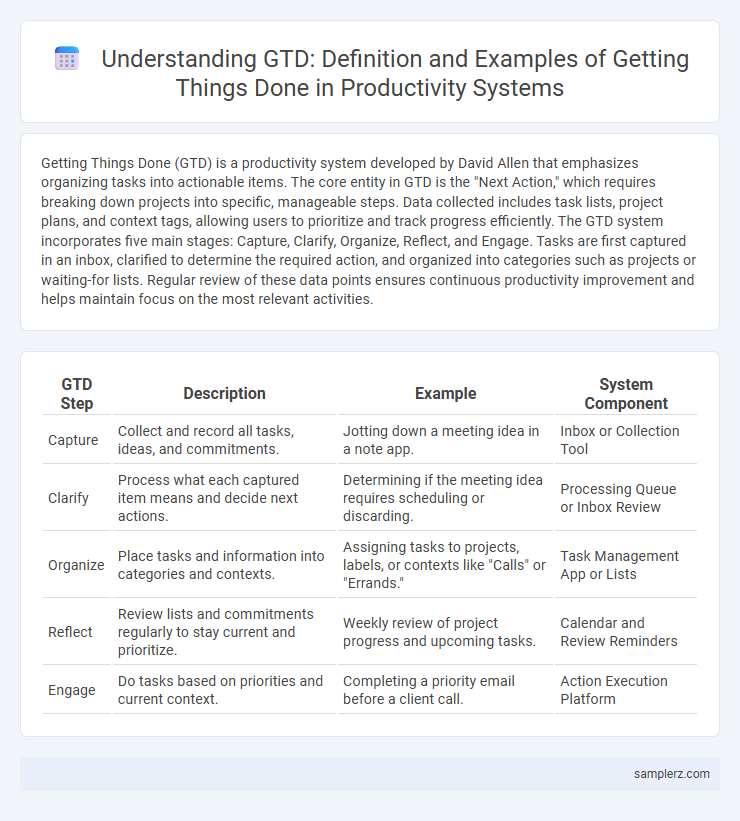Getting Things Done (GTD) is a productivity system developed by David Allen that emphasizes organizing tasks into actionable items. The core entity in GTD is the "Next Action," which requires breaking down projects into specific, manageable steps. Data collected includes task lists, project plans, and context tags, allowing users to prioritize and track progress efficiently. The GTD system incorporates five main stages: Capture, Clarify, Organize, Reflect, and Engage. Tasks are first captured in an inbox, clarified to determine the required action, and organized into categories such as projects or waiting-for lists. Regular review of these data points ensures continuous productivity improvement and helps maintain focus on the most relevant activities.
Table of Comparison
| GTD Step | Description | Example | System Component |
|---|---|---|---|
| Capture | Collect and record all tasks, ideas, and commitments. | Jotting down a meeting idea in a note app. | Inbox or Collection Tool |
| Clarify | Process what each captured item means and decide next actions. | Determining if the meeting idea requires scheduling or discarding. | Processing Queue or Inbox Review |
| Organize | Place tasks and information into categories and contexts. | Assigning tasks to projects, labels, or contexts like "Calls" or "Errands." | Task Management App or Lists |
| Reflect | Review lists and commitments regularly to stay current and prioritize. | Weekly review of project progress and upcoming tasks. | Calendar and Review Reminders |
| Engage | Do tasks based on priorities and current context. | Completing a priority email before a client call. | Action Execution Platform |
Introduction to Getting Things Done (GTD) Methodology
The Getting Things Done (GTD) methodology, created by David Allen, emphasizes capturing ideas and tasks in an external system to clear mental clutter and enhance focus. It involves five key steps: capture, clarify, organize, reflect, and engage, ensuring all commitments are processed efficiently. Implementing GTD leads to improved productivity by providing a structured approach to task management and minimizing stress from overload.
Essential Components of a GTD System
A GTD system hinges on five essential components: capture, clarify, organize, reflect, and engage, ensuring all tasks and ideas are systematically managed. Capturing involves collecting inputs from various sources, while clarifying breaks down tasks into actionable steps. Organizing places these actions into categories and contexts, reflecting regularly reviews progress, and engaging drives focused task completion.
Setting Up a GTD Workflow: Step-by-Step Example
Setting up a GTD workflow begins with capturing all tasks and ideas into a trusted collection system, such as a digital app like Todoist or a physical inbox tray. Next, clarify each item by determining actionable steps, then organize tasks by priority and context using folders, tags, or lists. Regularly review and update the system to maintain focus and ensure projects progress efficiently, optimizing productivity with the GTD methodology.
Capturing Tasks with GTD: Real-life Scenarios
Capturing tasks with GTD involves systematically collecting all actionable items in a trusted system, such as a digital app or notebook, to prevent mental clutter. For example, during meetings, professionals immediately record ideas and commitments in tools like Todoist or Evernote, ensuring nothing is lost. This approach enhances focus, enabling smoother task management and higher productivity.
Organizing Information in a GTD System
Organizing information in a GTD system involves categorizing tasks into actionable lists such as Next Actions, Waiting For, and Someday/Maybe, ensuring clarity and prioritization. Utilizing tools like digital apps (e.g., Todoist, Evernote) or physical notebooks enhances capturing and sorting inputs effectively. Consistent review cycles maintain an updated overview, fostering stress-free productivity and timely task completion.
Clarifying and Processing Tasks: Example Breakdown
In the GTD system, clarifying and processing tasks involves capturing every actionable item and deciding the next physical action required to move it forward. For example, an ambiguous item like "Plan project" is broken down into specific steps such as defining objectives, outlining deliverables, and scheduling team meetings. This precise breakdown minimizes decision fatigue and ensures tasks are manageable and clearly defined for immediate execution.
Using GTD for Effective Task Prioritization
Using the Getting Things Done (GTD) method enhances task prioritization by capturing all tasks and ideas into a trusted system, freeing mental space. Tasks are clarified through defined next actions, enabling clear decisions on what requires immediate attention, what can be delegated, and what should be deferred. The GTD system's use of contexts and review cycles ensures consistent evaluation and adjustment of priorities, driving effective productivity and reduced overwhelm.
Reviewing Your GTD System: Best Practices
Regularly reviewing your GTD system ensures tasks remain organized and priorities aligned with current goals. Evaluate project lists, update next actions, and clear completed tasks to maintain clarity and momentum. Consistent weekly reviews foster effective time management and enhanced productivity by preventing backlog accumulation.
Tools and Apps that Support GTD Implementation
Tools like Todoist, Microsoft To Do, and Evernote enhance GTD implementation by organizing tasks into actionable lists and context-based categories. Apps such as Trello and Asana support project tracking and collaboration, enabling users to capture, clarify, and review tasks seamlessly. Digital reminders and calendar integrations within these tools maintain workflow momentum and ensure consistent productivity adherence.
Benefits of GTD in Enhancing Productivity
GTD (Getting Things Done) system enhances productivity by providing a clear framework for capturing, clarifying, and organizing tasks, reducing cognitive overload. Its structured approach enables prioritizing actions efficiently, leading to improved focus and timely completion of projects. Regular reviews in GTD ensure continuous progress tracking and adaptability, minimizing stress and boosting overall work performance.

example of GTD in system Infographic
 samplerz.com
samplerz.com